Jan 12, 2021
Why are Welded Boat Lift Frames Superior?
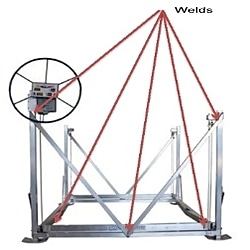
Welds on Vertical Lift Frames
Welded boat lift frames are superior to the typical bolt-together structures found so frequently. There are several reasons for this.
Most of them center around the reduced maintenance, superior strength, and durability of welded lifts and canopy frames.
You spent good money when you bought the boat lift or canopy. Shouldn’t you get the best one available?
Why would you want to spend a weekend checking and tightening the nuts and bolts on your boat lift or canopy? We’re pretty sure you don’t.
In that case, why not purchase a high-quality boat lift or canopy, which has most of its critical components welded together.
ShoreMaster welded boat lift frames and canopies leave you free to enjoy your time away. Why waste any time tightening nuts and bolts. Your time is too valuable.
Quality starts with state-of-the-art welding.
Welded Frames = Less Maintenance
ShoreMaster welded boat lifts save you time because they require less maintenance and give you more strength.
Welded Boat Lift Frames Stay True and Square
Bolt-together boat lifts eventually become loose due to everyday use and prolonged periods of heavy waves striking the frame. Corrosion of the hardware only accelerates this process.
If you neglect to tighten a loose bolt on your boat lift, other parts of the boat lift such as the cables, pulleys, winch, or other components can wear prematurely.
A loose bolt will result in the frame shifting, which may result in a costly repair.
Loose bolts make it extremely difficult for you to discover the source of the failure.
How do you know when you have loose bolts?
A simple test is to push on one corner of the bat lift. If there is excessive movement in the frames, in particular forward and backward, you have one of two situations:
- One of more bolts are loose; or
- The lift is not sitting firmly on the bottom.
What about a canopy frame?
A welded boat lift canopy frame can save you hours in assembly time. Using just five bolts for a welded frame vs. dozens of nuts and bolts makes sense. A welded canopy frame adds more strength and rigidity to the entire boat lift also.
When it comes to assembling a boat lift, or canopy, you’ll be glad that you choose a welded product over a bolt together product.
Also, welded products take less time to assemble than a bolt together product.
Consider for a moment just one person can complete the assembly of a ShoreMaster canopy frame in as little as 30 minutes because the canopy frame includes only four all-welded components; two canopy ends and two canopy sides. Other manufacturers have dozens of parts that need bolting together.
ShoreMaster welded boat lifts do not require replacing frame parts caused by unusual wear due to loose, missing, or corroded welds. A bolt-together frame cannot say the same thing. ShoreMaster adds thick reinforcing plates on the frame structure when using bolts structure.
A Welded Boat Lift Offers Higher Resale Value
Because welds are permanent and require no maintenance, you will find that your welded-together boat lifts are more valuable at resale time. Welds will not rust or corrode like hardware. Potential buyers will be wary of the impending costs to replace worn out or corroded hardware.
Where is Pier & Waterfront Solutions?
Located at 7325 St. Hwy 57, it’s 3 miles south of Sturgeon Bay and 1 mile PAST, Cty MM’s intersection (heading north). Look on the right at the intersection of Idlewild Road and Hwy 57.
ARE WE OPEN?
Pier & Waterfront Solutions remains “open” year-round.
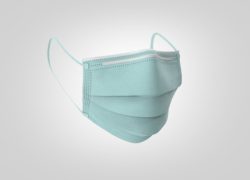
Please use face masks
The virus continues to spread. PWS is conducting as much business as possible by email, text, or phone.
Site visits continue as usual. When in-person contacts are necessary, we follow “social distancing” guidelines as closely as possible.
Our display yard is OPEN 24-7
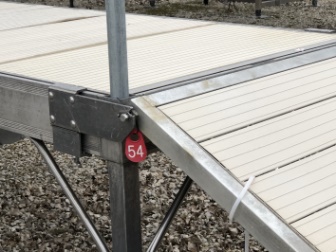
Red Tag
PWS‘s display area is always open for you to examine at your leisure. All displays available for sale have a numbered, red tag on them. If you want more information or pricing, please reference that number when you inquire.
We provide estimates and quotes by email to make the process faster, safer, and paperless.
What can YOU do?
Please conduct as much business as possible via emails, messaging, and phones. When you see our staff and crews on-site, please practice “social distancing.”
Call, message, or email us with any questions.
Thank you for allowing us to work with you safely.
Let’s all stay safe!
Jan 5, 2021
Boat Lift Styles
In Wisconsin waters, there are (5) different boat lift styles generally used. The (5) styles include:
- Cantilever,
- Vertical,
- Hydraulic,
- Floating, and
- Elevator boat lifts.
Different conditions require different boat lifts.
Cantilever Lift
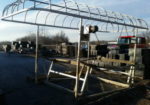
Cantilever Boat Lift Style
If you are on an inland lake or river where the water depth does not fluctuate more than 12″ throughout the boating season and wave action does not exceed 6″, a cantilever lift is generally suitable for you.
Cantilever lifts requires about 12″ of water plus the draft of your boat to operate. The lifting rack requires that depth of water due to the shape of the frames.
At first glance, that seems deep enough for most boats, but you still have to allow enough water above the rack to float your boat.
The real limitation of a cantilever lift is the total lifting height. If a river rises, especially after a heavy rainstorm, a boat can easily float off the lift. The boat is not up high enough to prevent the water from washing it away. Who knows how far it will travel before it hits something?
The normal lifting range is between 40″ and 48″. Remember, the rack starts at 12″ plus the draft of your boat, so you are usually less than 12″ above the water at its highest point.
Vertical Lift
On any large body of water, a vertical lift is the recommended lift for most people. Vertical lifts do a better job of protecting your boat from waves.
Some vertical lifts require about 6″-10″ of water plus the draft of the boat. As an example, ShoreMaster vertical boat lifts require only 6″ of water (plus the draft of your boat). Given the same conditions, you have already gained 6″ with this one feature alone.
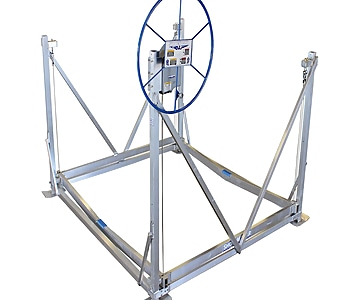
Vertical Boat Lift Style
Now, add the total lifting height of 66″ for a ShoreMaster vertical lift, and you gained a minimum of 18 or more inches of protection vs. a cantilever lift.
Your most significant protection comes from the lifting height. Don’t forget about the strength of the lift frame and the gauge of the material used. ONLY the ShoreMaster boat lift has welded side frames with heavy-duty square or rectangular frames for more strength.
Other brands require several packages of bolts and nuts to assemble the frames. Eventually, the holes for the bolts enlarge, and the frames begin to sway. The solid welded frame is a real advantage at this time. A minimal number of bolts are needed.
Can a lift raise a boat TOO high?
Strange as it may seem, it is possible to go too high. How? When the frames are not strong enough to handle the leverage of the weight from the boat.
At least one brand does lift higher than a ShoreMaster lift, but they failed to use welded frames for the additional strength it needs.
If you can imagine the forces acting against the frames in a storm when you have thousands of pounds suspended in the air with only simple bolts to hold them together. The higher the boat is, the greater the leverage on the frames.
Their leg wall thickness is not heavy enough to handle the forces acting against it. Green Bay produces more than 4′ high waves, and the waves frequently strike against the bottom of a boat, adding to the leverage problems.
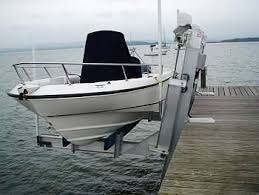
Elevator Boat Lift Style
Elevator Lift
Used with permanent pier installations, Elevator Lifts are a great combination. They raise the boat from the side, making access to the lift very easy.
Narrow channels and areas experiencing large fluctuations in water depth or hurricanes require elevator lifts.
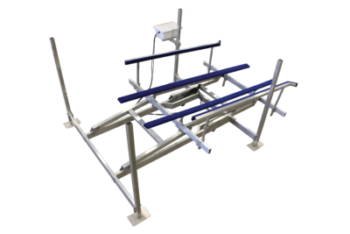
Hydraulic Boat Lifts Style
Hydraulic Boat Lift
A hydraulic lift generally lifts the highest – up to 6′ high in some cases. This height, along with the wide stance of the base, gives excellent protection for your boat. The hydraulic lift handles high waves and water surges during storms also.
These D.C. operated units are:
- Quiet:
- Smooth operating;
- Solar-powered;
- Wireless remote-controlled (There are no wheels to contend with.)
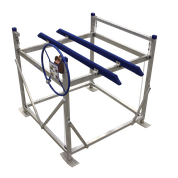
Vertical PWC Boat Lift
Vertical PWC Lift
Jet Ski lifts come in 3 styles: Vertical, Cantilever, and Floating.
The vertical PWC lifts allow you to get into shallow water and raise your boat higher than the cantilever type. They operate in the same fashion as a standard vertical boat lift and provide more protection for your PWC.
The PWC cantilever lift works fine on small lakes and rivers that do not fluctuate in depth or have high waves.
SHOREPORT
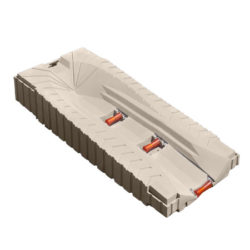
ShorePort PWC Boat Lift Style
The floating lifts (ShorePort) are excellent on rivers that fluctuate a lot in depth or inland lakes. These are very simple to use and require very little water to operate. The floating lift has no maintenance and you simply drive up onto the floating unit. No wheel cranking involved.
Wave action above 12” is not recommended for this type of “lift”. Combine a floating dock with the PWC floating lift and you have the perfect combination for a lake or river that fluctuates during the season but does not have large wave action.
Caution – when using any PWC lift – If you have a sand or small rock bottom near the shore use caution when approaching the lift. Sand and small stones can be sucked into the intake and destroy your motor.
For more information see also: www.wisconsinpws.com/boat-lift-size-correct-one/ and https://wisconsinpws.com/boat-lift-selection/
Where is Pier & Waterfront Solutions?
Located at 7325 St. Hwy 57, it’s 3 miles south of Sturgeon Bay and 1 mile PAST the intersection of Cty MM (heading north). Look on the right at the intersection of Idlewild Road and Hwy 57.
ARE WE OPEN?

Please use face masks
Pier & Waterfront Solutions remains “open” year-round.
The virus continues to spread. PWS is conducting as much business as possible by email, text, or phone.
Site visits continue as usual. When in-person contacts are necessary, we follow “social distancing” guidelines as closely as possible.
Our display yard is OPEN 24-7

Red Tag
PWS‘s display yard is always open for you to examine at your leisure. All displays available for sale have a numbered, red tag on them. If you want more information or pricing, please reference that number when you inquire.
We provide estimates and quotes by email to make the process faster, safer, and paperless.
What can YOU do?
Please conduct as much business as possible via emails, messaging, and phones. When you see our staff and crews on-site, please practice “social distancing.”
Call, message, or email us with any questions.
Thank you for allowing us to work with you safely.
Let’s all stay safe!
Dec 1, 2020
How to Flush a PWC engine.
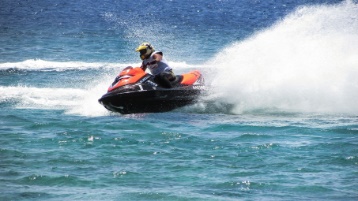
PWC Adventures
After a day of use, all personal watercraft (PWC) should be flushed, especially if used in silty or sandy areas. Flushing debris from the engine cooling system and exhaust will help prevent internal corrosion and keep those critical cooling passages running clear. Your PWC will be ready for operation when you are.
You want to continue to enjoy your PWC for years to come – Right?
Here’s how to flush a PWC engine.
Follow these 12 steps for flushing and cleaning a PWC.
This information is limited to an overview only. Remember, always find and follow the instructions for your model before flushing for the first time.
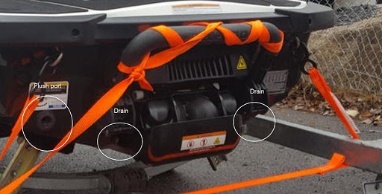
SeaDoo PWC Drain locations
- Locate the flush port(s). You will generally find flush ports on the transom or under the seat. It depends on your model.
- Attach the garden hose to the flush-fitting, but do not start the flow of water. That’s very important!
- Follow your owner’s manual. It may instruct you to idle for 90 seconds to 3 minutes.
- Idle the engine but do not rev the engine. Start the flow of water. Starting the water flow before starting the engine could result in water flowing into the engine through the exhaust system.
- After flushing, turn the water off and disconnect the hose. Now shut down the engine.
- Replace the plug.
Caution
Once done flushing, remember to turn the water off first. Some brands may instruct you to spike the throttle a few times before shutting down the engine to clear water from the exhaust.
Follow Your PWC Owner’s Manual.
These are general instructions. For flushing instructions specific to your model, consult the owner’s manual maintenance section. Can’t find the manual? Check the manufacturer’s website or visit the dealer.
On models with a closed cooling system (most late-model Sea-Doo PWCs), flush only the exhaust.
For other brands and models, flush the exhaust and the engine cooling passages. See the manual for details.
Follow the flushing instructions for your particular brand.
Failure to follow instructions may allow water to get into the engine, leading to corrosion and repairs.
You can flush the PWC while it is on a trailer or a lift, but it must be out of the water.
Want to clean the PWC further?
Find the flush port. Most brands have a flush port on the back of the hull. An alternative is under the seat or in the engine compartment. Check your owner’s manual for the proper location. Some flush ports accept the male end of a garden hose. Others use a snap-in adaptor that screws onto the garden hose. The adaptor would have been supplied with the PWC when it was new. If you don’t have any required adaptors for your model, you can get one from a dealer.
Now it’s time to clean the engine bay.
1. Remove the seat sections and any covers under it to see the engine.
2. Make sure the engine has cooled. Never rinse a hot engine.
3. Raise the bow of the PWC. Remove the drain plug from the hull so that rinse water can exit.
4. Using your water hose, rinse the cooled engine area and the bilge. It’s OK to use your thumb to make a spray of water. Don’t use a nozzle that puts out a lot of pressure. NEVER USE A PRESSURE WASHER. Too much water pressure can force water past the seals on electrical connectors.
5. Use an old towel or rags to wipe off all excess water from areas you can reach.
6. Spray down the engine components with a water-displacing lubricant (PWC dealers offer these or simply use WD-40). The oil will displace water left behind and leave a thin, anti-corrosive film.
How to store a PWC.
Store the PWC with the seat off to let the engine compartment dry completely. You can leave the bow up to facilitate draining. Remember to replace the drain plug before using the unit again. Leave yourself a reminder, like a cloth tied to the handlebar.
Conclusion
PWS has the answers for many of your dock, lift, and boating questions
Call Jerry at Pier & Waterfront Solutions (920-493-4404) for more information.
Where is Pier & Waterfront Solutions?
Located at 7325 St. Hwy 57, it’s 3 miles south of Sturgeon Bay and 1 mile past the intersection of Cty MM (heading north). Look on the right at the intersection of Idlewild Road and Hwy 57.
ARE WE OPEN?
Pier & Waterfront Solutions remains “open.”
We have implemented measures to guard the safety of our employees and visitors. At the same time, we are working to maintain the trusted service you expect.

Please use face masks
PWS is conducting as much business as possible by email, text, or phone.
Site visits continue as usual. When in-person contacts are necessary, we follow “social distancing” guidelines as closely as possible.
Our display yard is OPEN
Our display yard is always open for you to examine at your leisure. All displays available for sale have a numbered, red tag on them. If you want more information or pricing, please reference that number when you call.
We provide estimates by email to make the process paperless, faster, and safer. Let’s get back to normal quickly.
What can YOU do to help us?
Please conduct as much business as possible via emails, messaging, and phone. When you see our crews on-site, please practice “social distancing.”
Call, message, or email us with any questions.
Thank you for allowing us to work with you safely.
Let’s all stay safe!
Aug 11, 2020
Stress – Even Boat Lifts experience it
Stress – Even boat lifts are under stress – this year more than ever before due to the high waters.
Why? High water increases the stress on your cables.
We’ve previously informed you of the danger to boat lift cables during a storm. If the waves hit the bottom of your boat it will momentarily lift the boat and then allow it to fall back on the rack. What if the cables are weakened by rust and frays? The “bouncing” effect can completely sever a cable into two pieces.
The boat only lifts a fraction of an inch – right?!!
How can that movement harm the cables?
Even though the boat only rises a fraction of an inch, the energy of the “falling” boat must be absorbed by the boat rack. The cables in each corner of the lift must, in turn, absorb the stress of a moving 3-5,000 pound boat.
Having said that, a weakened cable is in imminent danger of breaking. Think of an 80-100 lb jackhammer used to break up concrete. Even reinforced concrete can not withstand the movement of the bit hitting the concrete.
With a boat, you are talking about a potential 5,000 lb weight dropping on a rack compared to an 80-100 lb. weight.
Protect your cables! It only takes a minute or two to protect your cables from rust. It’s simple and easy to do. A convenient link* is provided below so you can learn more about this.
What are the defect warning signs?
There are warning signs of defects in your cables? If your cables look like any of these, it’s time to replace them. Need more information? Here’s an article that addresses this issue.
Always remember – it is possible to have broken strands inside your cable without any exterior signs of damage. This situation is especially true on stainless steel cables which do not rust.
What’s a quick way to reduce the stress on the cables?
At the beginning of the year, we place your boat lift in the requested location. We adjust the height of the legs based on what the current water level is.
Unfortunately, the water has continued to rise this year and that may no longer be suitable for the conditions you have today. Add to this the Seiche waves (pronounced “say-sh”) which are standing waves that form in a confined body of water. The friction of the wind against the surface of the water causes wave action.
As waves move towards the shoreline the water gets shallower and the moving waves rise higher. Standing waves, in general, can form in any type of semi-enclosed or enclosed body of water. When these rising waves hit the bottom of your boat the boat does what it is designed to do – it floats on the water.
Your Lift rack may be too close
The lift rack could be too close to the water to protect your boat with the rising water. As a result, you are not able to raise the boat high enough to keep it above the waves. On the other hand, If the rack is set too high in the water, you may not be able to get your boat on the lift. It’s a delicate balance. The variable is the changing depth of the water.
What can I do?
One way to raise the boat higher is to purchase longer legs and replace the standard lengths with new ones.
A less costly alternative is to simply move your lift closer to shore. It will be in shallower water and save you having to buy longer legs and the labor to install them.
If you keep the standard legs and don’t allow us to place the lift closer to the shore, you are inviting costly repairs or even replacements.
In Conclusion
Get out there and take care of those cables. Check out the link below. Then, consider moving the lift closer to shore.
* Wire Rope Lubrication link.
Tell Your Friends & Family
Have friends or neighbors you believe should see this article? Email them a link to this article – and Thank you!
You can visit Pier & Waterfront Solutions on Facebook also.
Don’t Forget – PWS is the expert when you have a waterfront problem!
Where is Pier & Waterfront Solutions?
Located at 7325 St. Hwy 57, we are about 3 miles south of Sturgeon Bay, and 1 mile past the intersection of Cty MM (heading north). Look for the intersection of Idlewild Road and Hwy 57.
ARE WE OPEN?
Pier & Waterfront Solutions has remained “open.” We have implemented measures to ensure the safety of our employees and visitors. As of Aug 1st, Wisconsin mandates the use of face masks. We also endorse this to slow the spread of Covid-19. It’s the only known method to control the spread at this time.
While all this is going on, we are working to maintain the trusted service you expect. That’s important to us.
We are conducting as much business as possible by email, text, or phone. Site visits will continue as usual. When in-person contacts are necessary, we follow “social distancing” guidelines as closely as possible.
When can I see the display yard?
Our display yard is always open for you to examine at your leisure. All displays have a numbered, red tag on them. If you want more information or pricing, please reference that number.
How will I get my estimate?
We provide estimates and invoices by email to make the process paperless and faster. With these measures, we hope everyone will stay safe, and we will be back to normal operations soon.
What can YOU do to help our crews?
Please conduct as much business as possible via emails, messaging, and emails. When you see our crews working in your area, please practice “social distancing.”
Call, message, or use this simple request form to get answers and quotes.
Thank you for allowing us to work with you – safely.
Let’s all stay safe!
Jun 16, 2020
A Boat Lift Safety Lesson
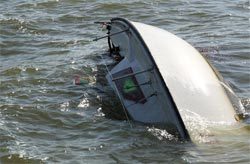
My lift cable broke…and I can’t ….
Proper boat lift safety means you won’t have to learn the tough lesson pictured here. If you apply these recommendations, you can relax and enjoy your boating experience.
Failure to follow these safety suggestions may result in damage to your boat or even personal injury.
Boat Lift Safety = Never exceeding the Ratings
The rated capacity of any lift is the maximum capacity, and you should never exceed that amount.
Boat weight INCLUDES more than just the published weight of the boat. It also includes the weight of fuel, water, and equipment. After all, you will be lifting all of this when you raise your boat. It adds up very quickly!
Plus, we recommend that you allow at least a 300-500# margin of error when you calculate the boat weight. See also: Sizing a Boatlifts: How to select the correct Boat Lift.
If you ever hear a salesperson say, “You can easily go 40% or 50% over that rating without a problem”. You are at risk of being the owner of the boat above if you follow that flawed thinking.
What’s the real story?
Lift cables are rated much higher than the rating of the boat lift. As an example, (using imaginary numbers) your boat lift has a 4,000# rating, it could have cables rated for 6,000# to 8,000#.
The cable rating may be 6,000#, but ONLY if the wires are in perfect shape – meaning no burrs, kinks, frays, or rust. These defects reduce the load capacity of the cables.
The lift racks are correctly rated for the weight regardless of the cable ratings. If someone is trying to sell you a 4,000# lift and telling you that it can handle up to 4,700# – WALK AWAY!!
The load must also be “balanced” on the rack for proper boat lift safety. (More on this later)
Lift cables fail without warning
Sorry!! Cables don’t “creak” or “groan” as a warning of impending danger. The only sound you hear is a loud “snap” followed by the sound of your boat hitting the water.
In a storm, you want to get your boat as high above the water as possible. Yet, raising a boat until the lifting platform or rack hits the frame is NOT the way to do it.
Hitting the frame is an all too common occurrence. Ask yourself, if raising the boat that extra ½” is worth snapping a cable. You risk damage to your boat and lift, or worse yet, personal injury.
Operate Lift Motors properly or break a cable
Properly used, an electric lift motor is a real back saver! I wouldn’t be without one. But you need to exercise extra care when using a lift motor. Shutting off a lift motor does not mean the lifting action will stop. What if it “drifts”?
For example, one brand of lift motor “drifts” after the motor stops. The “drift” potentially causes the lift rack and frame to jam together.
Cable failure, lift or boat damage, personal injury, or worse may be the result.
When the rack hits the lift frame, something has to give. The most likely culprit will be the cables. If you combine a damaged cable with a rack hitting the frame, you have a recipe for disaster.
OK, You Jammed the Rack & Frame! – What comes next?
You were distracted, and now the rack is jammed against the frame. A jammed rack means your next step is critical.
You’re in a hurry to release the pressure, but be sure you know which way the motor will go when you flip the switch.
If the rack isn’t going “DOWN,” damage occurs almost instantly. If it is a broken cable – your boat goes down – even faster!! Starting the winch or motor in the wrong direction could mean your boat will be in the water in an instant. Did I mention it won’t be floating?
Proper Positioning of the boat is part of boat lift safety.
As if a jammed rack wasn’t enough, did you know there are right ways and wrong ways to position your boat on your lift?
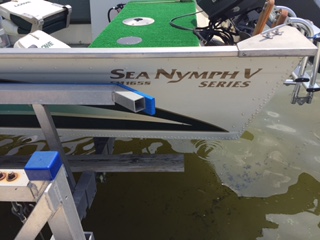
Boat stern overhanging too far
All lift ratings are based on a “balanced load.” In other words, the weight of the boat must be relatively equal on each end of the rack.
When you put the majority of the weight on one end of the rack, cable breakage is more likely.
The heaviest part of any boat will be where the engine is mounted. That could be at the stern (outboards) or even near the middle of the boat (inboards).
A boat placed too far forward on the lift rack results in excessive weight on the “front” of the lift. Too far to the stern of the boat puts too much weight on the rear cables. If the cables have weakened by corrosion or fraying, you risk impending disaster.
What is the correct position for a boat on a lift?
You can determine the proper positioning of a boat by placing the stern of the boat within 12″ – 18″ of the rear lift rack. Now, raise the rack slightly out of the water.
Next, try to lift the bow end with your hands. If the boat weighs 3,500# and you can lift the front of the boat, you are either “Mr. Atlas” or the boat is positioned to the rear. If you can lift the bow at all, your boat is too far back. The weight is not evenly distributed across the four corners of the lift. Lower the boat and reposition it forward.
The boat shown here overhangs about 36″ from the rack and risking major damage. By placing the boat too far back on the rack, a majority of the weight is on the rear cables. What if those cables are weak from corrosion or fraying?
Does high water affect the positioning of a boat?
Yes, it does. In the example above, with the rear of the rack overloaded, the boat has only minimal weight on the front rack.
Your boat will float on a wave. When the bottom of the boat is “lapped” by a wave, it will try to raise the boat. With repeated lifting (or bouncing) the boat can work it’s way off the rack. It will try to go go to the rear. Eventually, the boat will literally “bounce” right off the lift.
With a balanced boat, you have a better chance of the boat staying on the rack.
Align the boat in the same position each time.
So, now you have repositioned your boat until you found a good position for a balanced load. What comes next?
It’s time to make a note of a fixed object on the boat and how it lines up with something on the lift. This is a good gauge for the next time you enter your lift. Always try to go back to this same position.
Summary
You now know the do’s and don’t of boat lift ratings and positioning for your boat. With this knowledge, you can Relax and Enjoy your boating experience.
Where is Pier & Waterfront Solutions?
Located at 7325 St. Hwy 57, it’s 3 miles south of Sturgeon Bay, and 1 mile past the intersection of Cty MM (heading north). Look on the right side, one mile north, at the next intersection (Idlewild Road and Hwy 57).
ARE WE OPEN?
During this time of uncertainty, Pier & Waterfront Solutions is staying “open.” We have implemented measures to ensure the safety of our employees and visitors. At the same time, we are working to maintain the trusted service that you have come to expect.
We are implementing these precautionary measures:
1. Conducting as much business as possible by email, text, or phone.
2. Site visits will continue but with limited in-person meetings. When in-person contacts are necessary, we will follow “social distancing” guidelines.
3. Our display yard is always open for you to examine at your leisure. All displays have a numbered, red tag on them. If you want more information or pricing, please reference that number.
That’s not all!
4. Some employees are working remotely, but they are always available by phone.
5. Any employee exhibiting symptoms or illness is sent home.
6. We provide estimates and invoices by email to make the process paperless and faster.
7. Crew starting times are being staggered to limit social interactions.
8. We keep the same crews together to limit cross interactions.
With these measures, we hope everyone will stay safe, and we will be back to normal operations soon.
What can YOU do to help us?
1. Please conduct as much business as possible via emails, messaging, and emails. This step protects everyone involved.
2. When you see our crews installing equipment, please practice “social distancing.”
So, YES – WE ARE OPEN!
Please call, message, or email us with any questions.
Thank you for allowing us to work with you.
Let’s all stay safe!
Contact:
Jerry @ (920) 493-4404 or Jerry@wisconsinpws.com – Commercial work & new/used Sales.
Dave @ (920) 905-2588 or Dave@wisconsinpws.com – Erosion control & shoreline work.
Jerry @ (920) 493-4404 or Jerry@wisconsinpws.com – Scheduling & Service work


















